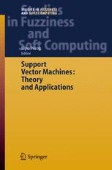Search
Search Results
-
COGNITIVE APPROACH TO MUSICAL DATA ANALYSIS
Digital signal processing is one of the most rapidly develo** areas of science. With the explosive expansion of the Internet, the number of very...
-
An Algorithm to Calculate the Expected Value of an Ongoing User Session
The fiercely competitive web-based electronic commerce environment has made necessary the application of intelligent methods to gather and analyze...
-
Fast Color Texture-Based Object Detection in Images: Application to License Plate Localization
The current chapter presents a color texture-based method for object detection in images. A support vector machine (SVM) is used to classify each...
-
Gas Sensing Using Support Vector Machines
In this chapter we deal with the use of Support Vector Machines in gas sensing. After a brief introduction to the inner workings of multisensor...
-
Support Vector Machines – An Introduction
This is a book about learning from empirical data (i.e., examples, samples, measurements, records, patterns or observations) by applying support...
-
Improving the Performance of the Support Vector Machine: Two Geometrical Scaling Methods
In this chapter, we discuss two possible ways of improving the performance of the SVM, using geometric methods. The first adapts the kernel by...
-
From Classical Connectionist Models to Probabilistic/Generalised Regression Neural Networks (PNNs/GRNNs)
This chapter begins by briefly summarising some of the well-known classical connectionist/artificial neural network models such as multi-layered...
-
Language and Thinking Modules
In this chapter, we focus upon the two modules which are closely tied to the concept of “action planning”, i.e. the 1) language and 2) thinking...
-
Sensation and Perception Modules
In any kind of creature, both the mechanisms of sensation and perception are indispensable for continuous living, e.g. to find edible plants/fruits...
-
The Mathematics of Learning: Dealing with Data *
Learning is key to develo** systems tailored to a broad range of data analysis and information extraction tasks. We outline the mathematical...
-
Web Page Classification*
This chapter describes systems that automatically classify web pages into meaningful categories. It first defines two types of web page...
-
Sequential Pattern Mining by Pattern-Growth: Principles and Extensions*
Sequential pattern mining is an important data mining problem with broad applications. However, it is also a challenging problem since the mining may...
-
Content Based Image Compression in Biomedical High-Throughput Screening Using Artificial Neural Networks
Biomedical High-Throughput Screening (HTS) requires specific properties of image compression. Particularly especially when archiving a huge number of...
-
Equivalence of Fuzzy Subgroups of Finite Abelian Groups
In this chapter, we determine the number of fuzzy subgroups of certain finite Abelian groups with respect to a suitable equivalence relation. This is...
-
Lattices of Fuzzy Subgroups
Many results concerning relationships between classes of crisp subsets can be carried over to similar relationships between classes of fuzzy subsets....
-
Discriminative Clustering of Yeast Stress Response
When a yeast cell is challenged by a rapid change in the conditions, be it temperature, osmolarity, pH, nutrient or other, it starts a genome stress...
-
Medical Bioinformatics: Detecting Molecular Diseases with Case-Based Reasoning
Based on the Human Genome Project, the new interdisciplinary subject of bioinformatics has become an important research topic during the last decade....
-
Cluster Identification Using Maximum Configuration Entropy
Clustering is an important task in data mining and machine learning. In this paper, a normalized graph sampling algorithm for clustering that...
-
First-Order Logic Based Formalism for Temporal Data Mining*
In this article we define a formalism for a methodology that has as purpose the discovery of knowledge, represented in the form of general Horn...
-
Identification of Critical Values in Latent Semantic Indexing
In this chapter we analyze the values used by Latent Semantic Indexing (LSI) for information retrieval. By manipulating the values in the Singular...
